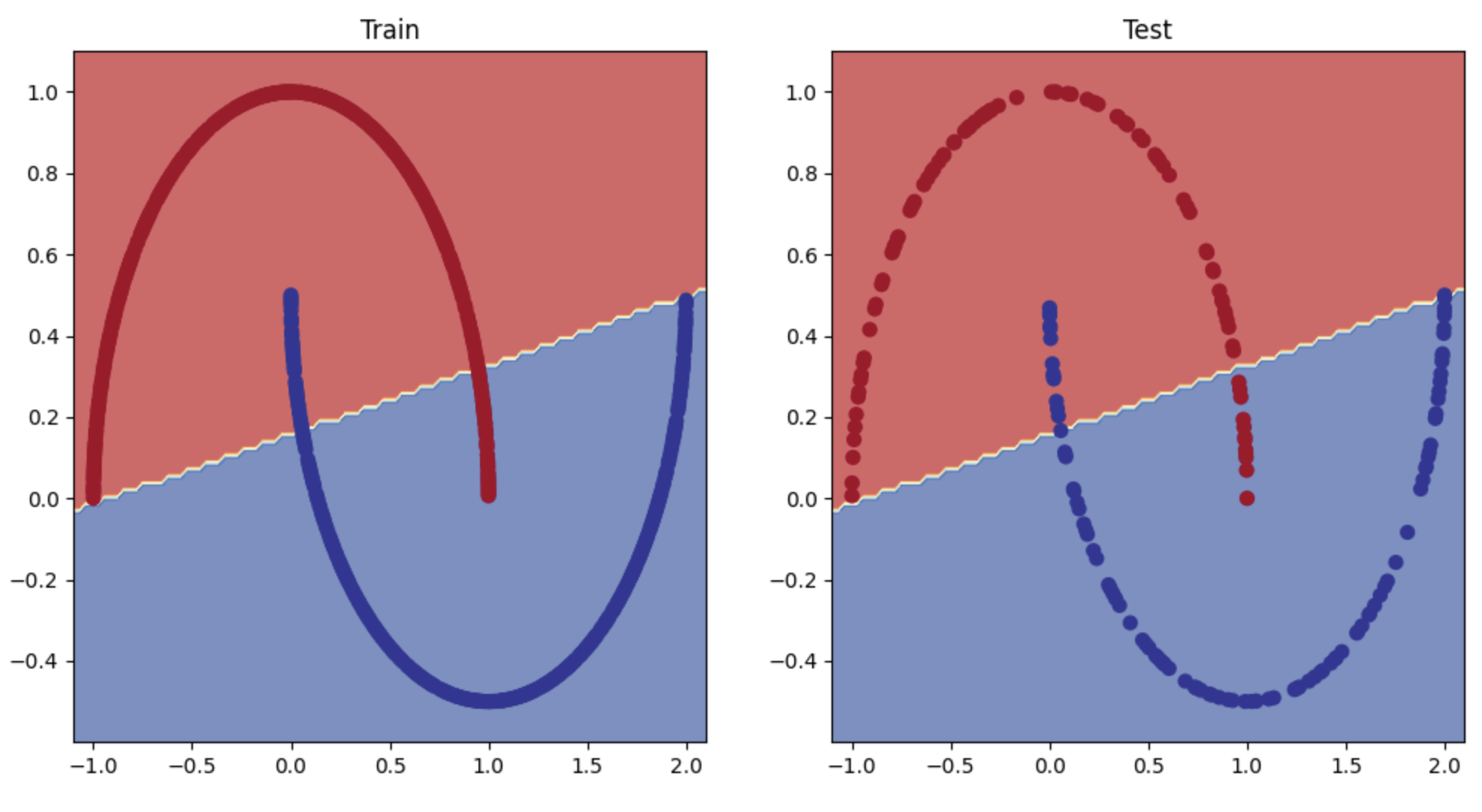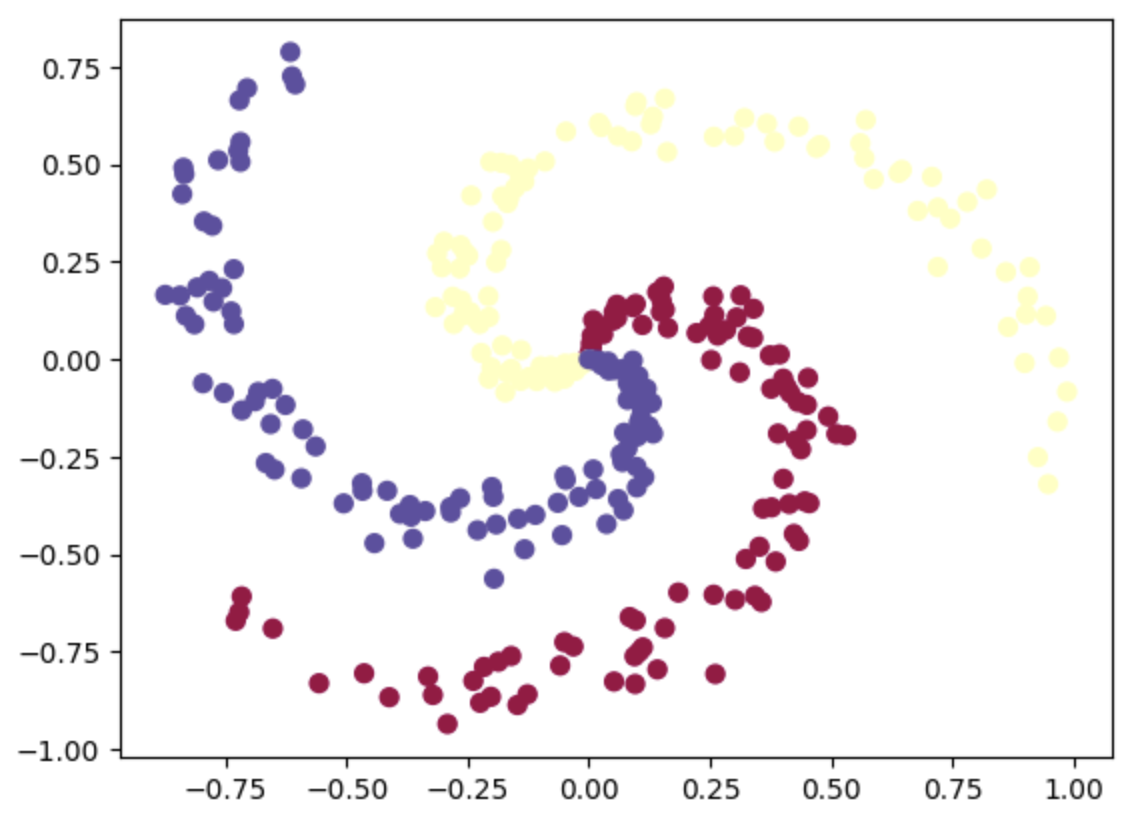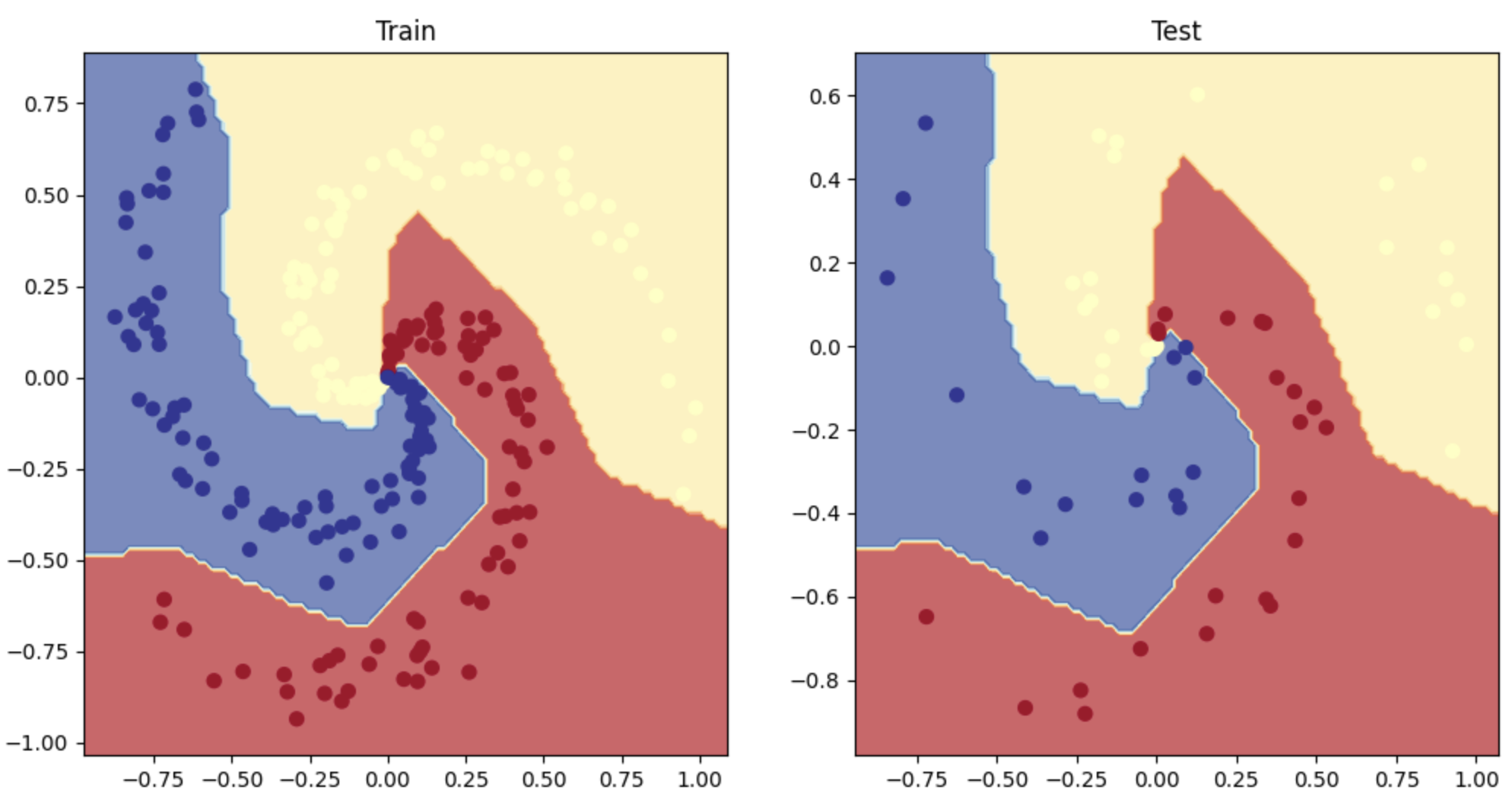PyTorch - Classification with Nerual Networks

This my solution and a brief summary to classification section of the PyTorch course that I'm going through right now.
The first exercise was to classify a moon data(interleaving half-circles) from the scikit learn dataset. As always, the first step is to visualize the data of the given problem.

It is possible to observe that a linear activation function might not be able to accurately describe the dataset as the data itself appears to be non-linear.
# Linear Model
class MoonModelV1(nn.Module):
def __init__(self, input_features, output_features, hidden_units=10):
super().__init__()
self.linear_layer_stack = nn.Sequential(
nn.Linear(in_features=input_features, out_features=hidden_units),
nn.Linear(in_features=hidden_units, out_features=hidden_units),
nn.Linear(in_features=hidden_units, out_features=output_features)
)
def forward(self, x):
return self.linear_layer_stack(x)
model_moon = MoonModelV1(input_features=2, output_features=1)
# Bincary cross entropy with Sigmoid layer loss function with SGD optimizer
loss_fn = nn.BCEWithLogitsLoss()()
optimizer = torch.optim.SGD(model_moon.parameters(), lr=0.1)In fact, without a non-linear layer within the model, it is difficult for the model to accurately capture the pattens of the data.

However, if we utilize non-linear activation functions between our layers, it is possible to capture the non-linear patterns from the moon data set. For this model, the ReLU function was used.
class MoonModelV2(nn.Module):
def __init__(self, input_features, output_features, hidden_units):
super().__init__()
self.linear_layer_stack = nn.Sequential(
nn.Linear(in_features=input_features, out_features=hidden_units),
nn.ReLU(),
nn.Linear(in_features=hidden_units, out_features=hidden_units),
nn.ReLU(),
nn.Linear(in_features=hidden_units, out_features=output_features)
)
def forward(self, x):
return self.linear_layer_stack(x)
# return self.layer_3(self.relu(self.layer_2(self.relu(self.layer_1(x))))) <-- equivalent
model_moon2 = MoonModelV2(input_features=2, output_features=1, hidden_unites=10)
# Binary Cross Entropy Loss Fn with SGD optimizer
loss_fn = nn.BCEWithLogitsLoss()
optimizer = torch.optim.SGD(model_moon.parameters(), lr=0.1)Now, it is possible to observe a significant improvement in accuracy compared to the previous non-linear model.

The other exercise was to generate a model that could classify a spiral shaped data set with 3 classes as shown below. The visualized data appears to be non-linear, and the ReLU activation function was used here to adress that as well.

This model is very similar to the previous classifications; however, achieving the predicted data during the training and testing process, as well as the loss function is a bit different from binary classifications.
For binary classifictions:
# Binary cross entropy loss function is used
loss = torch.nn.BCELossWithLogits or torch.nn.BCELoss
# logits --> prediction probabilities --> prediciton data
y_pred_probs = torch.sigmoid(y_logits) # convert the logits into probabilities using sigmoid function
y_pred = torch.round(y_pred_probs) # classify 1 or 0 at the break point of 0.5For multi-class classifictions:
# Cross entropy loss function is used
loss = torch.nn.CrossEntropyLoss
# logits --> prediction probabilities --> prediciton data
y_pred_probs = torch.softmax(y_logits) # convert the logits into probabilities using softmax function
y_pred = torch.argmax(y_pred_probs) # return the class with the highest probabilityTo summarize, classification requires some type of activation functions that could normalize the data into some probability distributions. Binary classification utilizes the sigmoid function as it maps/squeezes the values into some values between 0 and 1(proabilities!). Multi-class classification uses the softmax function to squeeze the values into a probability distribution. Then, these probabilities can be retrieved to identify a class that is more likely.
class SpiralModel(nn.Module):
def __init__(self, input_features, output_features, hidden_units):
super().__init__()
self.linear_layer_stack = nn.Sequential(
nn.Linear(in_features=input_features, out_features=hidden_units),
nn.ReLU(),
nn.Linear(in_features=hidden_units, out_features=hidden_units),
nn.ReLU(),
nn.Linear(in_features=hidden_units, out_features=output_features)
)
def forward(self, x):
return self.linear_layer_stack(x)
model_spiral = SpiralModel(input_features=2, output_features=3, hidden_units=10)
loss_fn = nn.CrossEntropyLoss()
optimizer = torch.optim.Adam(model_spiral.parameters(), lr=0.1)Using this non-linear multi-class classification model, it was possible to accurately classify the spiral dataset and its features as shown below. Thanks for reading!
